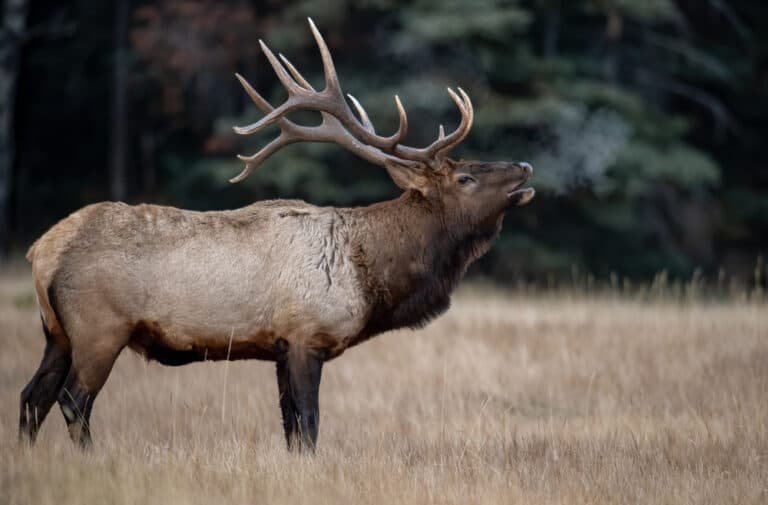Kentucky Elk Hunting: 3 Amazing Tips for Greater Success
Kentucky, known as the “Bluegrass State,” boasts a longstanding hunting heritage that stretches back centuries. From the days of early settlers relying on hunting for sustenance to the modern-day pursuit of wildlife, Kentuckians have always had a deep connection to the land and its abundant natural resources. Hunting traditions have been passed down through generations and ingrained in the cultural fabric of this great state, which is why Kentucky elk hunting is so popular.

The Majestic Elk Species in Kentucky
The majestic elk is an iconic symbol of wild beauty and grace that roams freely in the verdant landscapes of Kentucky. Once extirpated from the region due to overhunting and habitat loss, elk were successfully reintroduced in 1997 as part of an ambitious wildlife restoration program.
Since then, these magnificent creatures have flourished and established self-sustaining populations within designated areas across the state. With their impressive antlers, which can reach widths exceeding six feet and weigh more than forty pounds, Kentucky’s elk captivate both hunters and nature enthusiasts alike.
Conservation and Ecosystem Management
Elk hunting in Kentucky is vital in conservation efforts and ecosystem management. Through carefully regulated hunting seasons and permits, state wildlife agencies strategically control population size while maintaining ecological balance.
The presence of predators being relatively scarce compared to historical times makes responsible human intervention necessary for managing sustainable herd sizes. By carefully managing elk populations through regulated hunts, authorities ensure that these magnificent animals do not exceed carrying capacity or negatively impact habitat quality.
Moreover, revenue generated from licensing fees for elk hunts directly contributes to funding conservation programs aimed at protecting these glorious animals and the diverse ecosystems they inhabit. Kentucky’s rich hunting heritage sets the stage for a remarkable elk-hunting experience.
The reintroduction of elk in the state has allowed hunters and nature enthusiasts alike to witness and appreciate the splendor of this majestic species. Furthermore, through regulated elk hunting, Kentucky demonstrates its commitment to conservation practices and ecosystem management, ensuring a balanced coexistence between humans and wildlife.
Understanding Kentucky’s Elk Population
The reintroduction of elk in Kentucky
The history of elk in Kentucky is a fascinating tale of conservation success. Once abundant throughout the state, elk were completely eradicated by the early 1900s due to unregulated hunting and habitat loss. However, the restoration efforts began in 1997 when the Kentucky Department of Fish and Wildlife Resources, in collaboration with various organizations and state agencies, initiated a reintroduction program.
1,550 elk were captured from several western states and released into five designated restoration zones across eastern Kentucky. This monumental endeavor aimed to bring back an iconic species and restore balance to the ecosystem.
Current status and growth of the elk population
Since their reintroduction over two decades ago, Kentucky’s elk population has experienced remarkable growth. Today, it is one of the largest free-ranging herds east of the Mississippi River.
According to recent estimates provided by wildlife biologists, there are approximately 11,000 elks spread across the state’s restoration zones. The success story continues as these magnificent animals thrive in their newfound habitat.
Distribution and habitat preferences of elk in the state
Elk are primarily concentrated within eastern Kentucky’s Appalachian mountains, where ample forested areas provide suitable habitat conditions for survival. The five designated restoration zones – Eastern Coalfield Zone, Knobs Region Zone, Southeast Zone, Northeast Zone, and Western/Central Zones – offer varied terrain ranging from steep slopes to valleys adorned with lush vegetation and clear streams.
Depending on seasonality and reproductive behaviors, elks exhibit specific habitat preferences within these zones. When forage is abundant in spring and summer, elks tend to roam higher elevations where grasses, sedges, and herbaceous plants flourish.
As autumn approaches, they migrate to lower altitudes, seeking mast-producing hardwood forests for abundant acorns and other nuts. Additionally, elk have shown a propensity for open meadows and fields as they provide ample grazing opportunities.
Understanding Kentucky elks’ distribution patterns and habitat preferences is essential for hunters and wildlife managers. It allows for effective management strategies that ensure the long-term viability of the elk population while providing optimal hunting experiences in designated areas.
Regulations and Licensing for Elk Hunting in Kentucky

The application process for obtaining an elk hunting permit
Securing an elk hunting permit in Kentucky requires a systematic approach to ensure fairness and sustainability. The Kentucky Department of Fish and Wildlife Resources (KDFWR) oversees the application process, which typically begins in the spring.
Interested hunters must submit their applications through a lottery system online or by mail. The application form mandates crucial information, such as personal details, hunter education certification, preferred hunt type (bull, cow, archery, firearm), and zone preference.
Applicants must also include their hunting license number, tag fee payment, and the application.
Different types of permits
The KDFWR offers various elk hunting permits for different preferences and wildlife management objectives. Bull permits allow hunters to pursue mature male elk during the rutting season when bulls are most active. Cow permits allow hunters to target female elk, contributing to population management efforts while offering exciting hunting opportunities.
Archery permits specifically cater to bowhunters who seek a more challenging experience by utilizing traditional or compound bows. Firearm permits are available for specific seasons designated by the KDFWR for those who prefer firearms.
Season dates, bag limits, and other important regulations
Elk hunting seasons in Kentucky are carefully regulated to ensure sustainable wildlife management practices while maximizing recreational opportunities for hunters. Season dates vary yearly but typically span from early September through January, with specific timeframes allocated for different hunt types (bull or cow) and weapons (archery or firearm).
Bag limits are set based on population dynamics and conservation goals but generally allow one elk per permit holder per season. Hunters must familiarize themselves with all applicable regulations before embarking on their elk hunting expedition in Kentucky, as violations can lead to severe penalties.
Preparing for a Successful Elk Hunt in Kentucky
Prime hunting areas within the state’s designated zones
Before embarking on an elk hunting expedition in Kentucky, conducting thorough research on prime hunting areas within the state’s designated zones is crucial. Kentucky has several wildlife management areas and preserves that provide suitable elk habitats.
These areas often have specific regulations and restrictions, so it is important to familiarize yourself with the rules and boundaries of each zone. Additionally, consulting with local wildlife agencies or experienced hunters can provide valuable insights into hotspots where elk are commonly found.
Understanding elk behavior and their rutting patterns
Understanding elk’s behavior and rutting patterns is essential to increase your chances of a successful hunt. Elk are highly social creatures that exhibit distinct behaviors during different seasons.
Researching their mating rituals, communication methods, and preferred habitats during different times of the year will help you plan your hunting strategy accordingly. Learning about their feeding habits, bedding locations, and preferred travel routes will enable you to anticipate their movements and position yourself strategically for a successful encounter.
Gear essentials: Firearms, archery equipment, clothing, optics
Equipping yourself with the right gear is paramount when preparing for an elk hunt in Kentucky. Whether you choose firearms or archery equipment, selecting a weapon that suits your skill level and personal preference is important.
Firearms should have sufficient power to harvest an elk at longer distances. For archers, choosing a bow with ample draw weight and appropriate broadheads is crucial for clean kills.
In addition to weapons, proper clothing suitable for various weather conditions should be chosen carefully to ensure comfort during long hours in the field. Optics such as binoculars or spotting scopes are indispensable for locating distant herds or scouting potential hunting spots.
Physical conditioning and mental preparedness
Elk hunting in Kentucky can be physically demanding, requiring endurance and strength. Therefore, a comprehensive physical conditioning program is vital before the hunting season commences.
Cardiovascular exercises, weight training, and hiking with a weighted backpack will help build stamina and enhance your ability to navigate difficult terrain. Mental preparedness is equally important, as elk hunts can be mentally draining due to their elusive nature.
Developing patience, focus, and adaptability will greatly contribute to your success as an elk hunter in Kentucky. By thoroughly researching prime hunting areas within Kentucky’s designated zones, understanding elk behavior and rutting patterns, ensuring appropriate gear selection, and investing time into physical conditioning and mental preparedness, you will be well-prepared for a successful elk hunt in the beautiful state of Kentucky.
Fundamental Techniques for Elk Hunting in Kentucky

Stalking: Approaching undetected through stealthy movements
Stalking is a crucial technique skilled elk hunters employ to get within range of their elusive targets. It involves moving silently and cautiously, blending seamlessly with the surroundings to avoid detection by the keen senses of these majestic creatures.
The key to successful stalking lies in patience, observation, and precise footwork. Hunters must move slowly, taking calculated steps while maintaining awareness of wind direction and noise discipline.
They should utilize natural cover such as trees, rocks, or vegetation to remain concealed as they steadily close the distance between themselves and the elk. It is essential to constantly scan the surroundings for any signs of movement or sound that may indicate the presence of an elk nearby.
Calling: Mastering various elk vocalizations to attract bulls
Calling is a time-tested technique that allows hunters to communicate with elk by mimicking their vocalizations. Bulls are particularly responsive during the rutting season when actively seeking mates and defending their territories.
To effectively call elk in Kentucky, hunters must master different sounds, including bugles, cow calls, and grunts or mews. Bugling can be especially effective when locating a bull or establishing dominance over other males.
Cow calls are useful for attracting bulls whom the prospect of mating opportunities may entice. By learning how to produce realistic calls using diaphragm calls or external calling devices such as bugle tubes or cow calls, hunters can greatly enhance their chances of drawing in curious bulls within shooting range.
Glassing: Utilizing binoculars or spotting scopes to locate herds from a distance
Glassing is a valuable technique that aids hunters in locating herds from afar without alerting them to their presence. By utilizing high-quality binoculars or spotting scopes, hunters can scan open plains, ridges, valleys, or other areas with good visibility to spot elk movements and patterns.
Glassing requires patience and a keen eye for detail. Hunters should focus on areas where elk are likely to feed, such as meadows or grassy clearings, and water sources where herds gather for hydration.
Additionally, using vantage points such as elevated positions or ridge lines can significantly enhance the effectiveness of glassing efforts. The objective is to gather valuable information about herd size, bull-to-cow ratios, and potential trophy animals before deciding on the next action.
Setting up ambushes near water sources or feeding areas
Setting up ambushes near water sources or feeding areas is a strategic tactic skilled elk hunters employ to capitalize on their prey’s predictable movement patterns. Elk require regular access to water for survival, making natural watering holes and creeks ideal locations for ambushes. Observing these spots during scouting missions will provide valuable insights into the time of day when elk frequent these watering sites.
Similarly, feeding areas like meadows with lush vegetation can attract herds during specific periods. Understanding the daily routines of elk and identifying their preferred grazing spots enables hunters to position themselves in concealed locations along known travel routes or near-prime feeding grounds in anticipation of their arrival.
Maintaining patience and stillness while waiting for an opportunity to present itself is vital. By mastering these fundamental techniques – stalking with stealthy movements, adeptly using calls to attract bulls, employing effective glassing methods for scouting purposes, and setting up well-planned ambushes – hunters in Kentucky can greatly enhance their chances of a successful elk hunting experience while immersing themselves in the beauty and challenge that this majestic species offers within its natural habitat.
Tips for Tracking and Field Dressing an Elk

Tracking wounded animals using blood trails or hoof prints
When tracking a wounded elk, honing your skills in reading blood trails and interpreting hoof prints is crucial. A keen eye and attention to detail are paramount in following the path of an injured animal. Start by identifying the type of blood trail—arterial, venous, or capillary—and assess the blood’s color, consistency, and quantity.
Arterial blood indicates a potentially lethal hit, while venous or capillary bleeding may require more time and patience. Additionally, scrutinize tracks left behind by the injured elk.
Look for signs of limping or dragging hooves disturbed vegetation, and broken branches along its route. Combining these observations with your knowledge of elk behavior and terrain features such as water sources or thick cover favored by wounded animals seeking refuge can increase your chances of successfully tracking down a wounded elk.
Proper shot placement to ensure ethical kills
Ethical hunting practices necessitate precise shot placement to ensure quick and humane kills. For elk hunting in Kentucky, it is essential to understand their anatomy and identify vital areas that yield efficient kills.
The most effective shot placement on an elk is typically behind the shoulder in the chest cavity, targeting vital organs such as the heart and lungs. This broadside shot allows for maximal tissue damage and rapid incapacitation—resulting in shorter tracking distances for recovered animals.
Avoid angling shots that may only graze non-vital areas or cause unnecessary suffering without delivering a swift kill—practice shooting from various positions to enhance accuracy in real hunting scenarios.
Field dressing techniques to preserve meat quality during transportation
Field dressing an elk correctly is crucial for preserving meat quality and ensuring safe transportation from the hunting grounds. After a successful harvest, dress the elk promptly to minimize the risk of spoilage and bacterial contamination.
Begin by making an incision from the sternum down to the pelvic bone, being careful not to puncture internal organs. Remove these organs in a controlled manner, taking care to avoid rupturing the bladder or intestines.
Cooling the meat as soon as possible is essential, especially during warmer weather conditions. Consider quartering and deboning the elk on-site, reducing its overall size for easier transport and allowing for faster cooling of individual pieces.
Pack and store each piece in game bags or coolers with ice packs to maintain freshness until you reach the proper processing facilities. By following these tips for tracking wounded animals, ensuring ethical shot placement, and employing effective field dressing techniques, you can maximize your success as an elk hunter in Kentucky while upholding conservation principles and responsible hunting practices.
Kentucky
Kentucky, known as the “Bluegrass State,” offers a remarkable hunting experience for elk enthusiasts. With its diverse terrain, ranging from rolling hills to dense forests, Kentucky provides a perfect habitat for elk herds to thrive. The state’s dedication to wildlife conservation and management has resulted in a flourishing elk population, making it an ideal destination for hunters seeking the challenge and adventure of pursuing these majestic creatures.
Natural Beauty and Rich History
Beyond its exceptional hunting opportunities, Kentucky boasts breathtaking landscapes that captivate the senses. From the stunning Appalachian Mountains in the east to the picturesque Cumberland Plateau in the west, hunters are treated to stunning vistas while immersing themselves in nature.
Furthermore, Kentucky’s historical significance adds an extra layer of intrigue to any hunting expedition. Exploring areas where pioneers once traveled and discovering remnants of bygone eras can transform a hunt into an enriching journey through time.
Hospitality and Culture
One cannot overlook the warm hospitality that Kentuckians extend to visitors. The locals take pride in their state’s hunting traditions and are always eager to share their knowledge and experiences with fellow hunters. Whether swapping stories at local diners or receiving tips from seasoned veterans at hunting lodges, embracing Kentucky’s vibrant culture enhances one’s overall experience.

Conclusion
Embarking on an elk hunt in Kentucky is not just about bagging a trophy but immersing oneself in a unique fusion of nature, history, and camaraderie. The state offers unparalleled beauty and excellent game management practices that ensure sustainable populations for future generations of hunters.
So pack your gear, head out into the wilderness of Kentucky, and embrace this exhilarating adventure like no other – you’ll create memories that will last a lifetime. Happy hunting!






